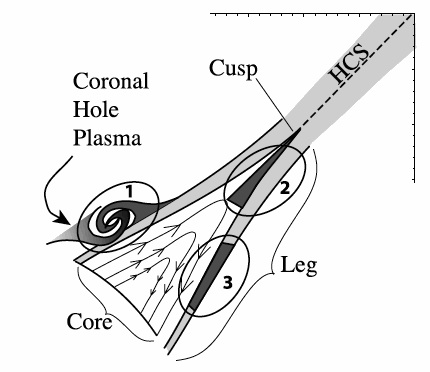
Suess, S. T., Y. K. Ko, R. von Steiger, and R. L. Moore, Quiescent current sheets in the solar wind and origins of slow wind, Journal of Geophysical Research (Space Physics), 114, A04103 (2009) (ADS)

(click on the image for a larger version)
Date: 2011 August 24
Update: 2019 December 01
This paper is not about flares, although it is about not flares in an interesting sense. A cusp-shaped magnetic geometry often forms the basis for one of our flare cartoons (the large fraction of the items in this Archive, in fact, that deal with CSHKP). In cases like this we are asked to believe that reconnection happens rapidly and that energy is released as a consequence. In this scenario the geometry is similar but the results are different: the streamer and its heliospheric current sheet (HCS) are quasi-permanent features of the landscape and are not engaged in energy release particularly. Nevertheless, as this paper discusses interestingly, there may be dynamics, and the effects discussed ought to be borne in mind for the flare or CME application as well. Note please the charming vortex on the active side (marked "1") of the streamer core. This would likely be the Kelvin-Helmholtz instability. In the meanwhile, we still don't know why reconnection does or does not occur, or how fast it may go. Please consider the "S-Web" in this context.
Isn't the use of "leg" in this cartoon (and in others dealing with streamers) a little bit odd? The use of the term "core" hints at a patch on the solar surface, and yet the HCS has to go all the way around the Sun. The patch therefore must be an annular strip, so "wall" might be better than "leg" geometrically?